You are hereBlogs / WcP.Observer's blog / Center of international finance, Wall Street: 700 people arrested in one day..Can buses be used for arrests? Bus company says no
Center of international finance, Wall Street: 700 people arrested in one day..Can buses be used for arrests? Bus company says no

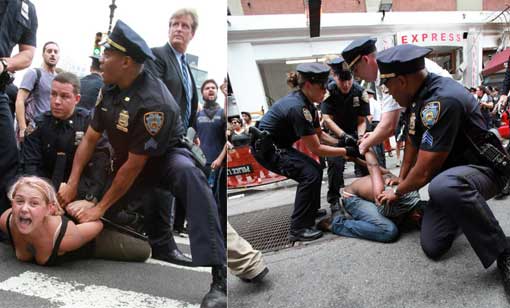
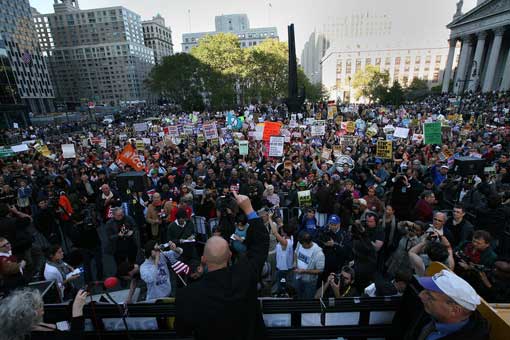
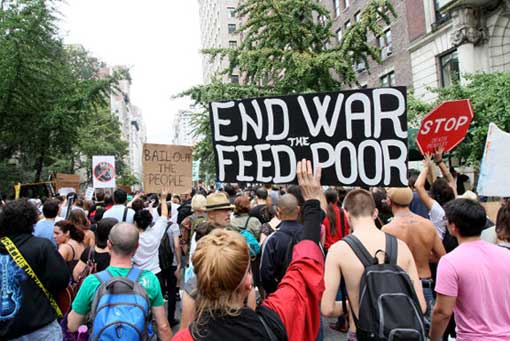

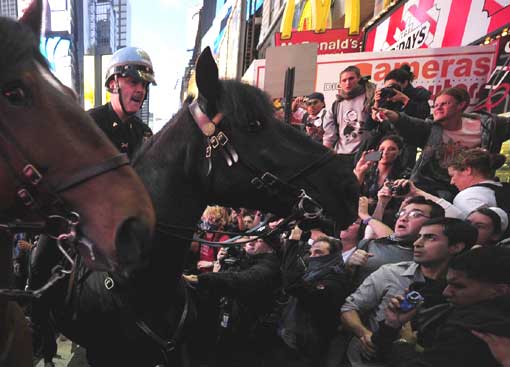
(quote)
N.Y. Police Can’t Use Bus Drivers in Protest Arrests, Union Says
Oct. 4 (Bloomberg) -- Police should be barred from forcing New York transit workers to abandon their routes and transport anti-Wall Street demonstrators arrested for disorderly conduct, an employees’ union told a federal judge.
The Transport Workers Union Local 100, which said last week that it’s supporting the protests, asked U.S. District Judge Paul Engelmayer to prohibit the New York City Police Department and the New York City Transit Authority from requiring drivers to transport such protesters.
A court hearing is set for today on the request, said Jim Gannon, a spokesman for the union, which represents 38,000 members, including about 9,000 city bus drivers. Drivers were ordered on Oct. 1 to convey some of the 700 demonstrators arrested over the weekend during anti-Wall Street protests in lower Manhattan.
"The actions of the NYPD on Oct. 1, 2011, amounted to a seizure of the bus drivers," Arthur Schwartz, a lawyer for the union, said in court papers. The police department "deprived the drivers of their liberty without due process of law," he said.
More Arrests
Five protesters were arrested yesterday, accused of wearing masks near Liberty Plaza in violation of a city law, said Paul Browne, an NYPD spokesman. Some protesters have gathered at the park, located a few blocks from the Federal Reserve and Wall Street.
Police commandeered about five buses after the Oct. 1 demonstration on the Brooklyn Bridge and ordered the drivers to transport protesters who were arrested, including one bus whose passengers were told to leave, Local 100 President John Samuelsen said.
The drivers -- some of whom were ordered by their supervisors to comply with the police -- didn’t resist, Samuelsen said. "There’s NYPD brass with guns on buses saying ‘Move the bus, this bus is now under the control of the NYPD,’" he said. "What room to protest is there? It’s not a transit supervisor you’re dealing with."
The anti-Wall Street protests were thrust into the national spotlight this weekend when police arrested the protesters for disorderly conduct on the Brooklyn Bridge. Demonstrators, originally walking on the span’s pedestrian footpath, converged on the roadway and were arrested on Oct. 1.
NYPD Cooperation
Only nine of those arrested by the NYPD weren’t released from holding facilities in Brooklyn and Manhattan, the union said in its lawsuit. Most of those arrested were given summonses and released. "We have no intention of changing our longstanding policy of cooperating with the NYPD," Jeremy Soffin, a spokesman for the state Metropolitan Transportation Authority, which operates the city’s buses and subways, said in an e-mail.
The union said yesterday in its lawsuit that more demonstrations are planned and transit workers and their buses will again be used improperly by authorities. "The Occupy Wall Street demonstrations are continuing," the union said in its lawsuit. "There is a great likelihood that on Oct. 5, or at future marches, the NYPD will engage in additional mass arrests, and that they will act as they did on Oct. 1, 2011, and commandeer buses and bus drivers."
‘No Imminent Danger’
Schwartz, the plaintiff’s lawyer, didn’t immediately return a voicemail message to his mobile phone or respond to an e-mail message seeking comment or update on the matter.
Samuelsen said authorities can only force people to assist police when there is "imminent danger". Local 100 members participate in "legitimate" police and fire department emergencies as needed, he said.
"There was no imminent danger here," Samuelsen said. "The protesters this weekend appeared to be marching peacefully, as is their right."
The case is Samuelsen v. Kelly, 11-cv-06947, U.S. District Court, Southern District of New York (Manhattan).
TWU blasts city for putting handcuffed Occupy Wall Street protesters on buses
Monday, October 3rd 2011, 4:00 AM
The Transport Workers Union will go to court Monday to try to stop the city from forcing bus drivers to transport Wall Street protesters arrested by the NYPD, the Daily News has learned. The union, whose leaders voted last week to support the protesters, said police brass commandeered three MTA buses to transport many of the 700 demonstrators arrested on the Brooklyn Bridge on Saturday.
"TWU Local 100 supports the protesters on Wall Street and takes great offense that the mayor and NYPD have ordered operators to transport citizens who were exercising their constitutional right to protest - and shouldn't have been arrested in the first place," Union President John Samuelsen said Sunday night.
At least five empty buses were commandeered from terminal points on both sides of the bridge, Samuelsen said. In some cases, MTA supervisors ordered drivers to follow the directive. "The MTA has a long history of cooperating with the NYPD and other law enforcement agencies when they require vehicles to perform their duties," said Jeremy Soffin, MTA spokesman.
But that violates the contract between Local 100 and the MTA, Samuelsen said. "Our mission is to provide transit service to the riding public, not transport people who were arrested," he said.
The mass roundup on the bridge did little to stifle the protesters: Hundreds went right back to the rally after getting sprung. "Just because we're being arrested, we're not being silenced," said Robert Grodt, 24. "You go to Italy, you eat gelato. You go to a protest, you expect to be arrested," said Daniel Levine, 22, a Baruch College journalism student. NYPD spokesman Paul Browne said 700 people received summonses and eight were held - three for outstanding warrants and five for not providing ID. He did not immediately comment on the TWU seeking an injunction.
The nebulous protest against corporate greed, income inequality and tax breaks for fat cats enters its third week with growing crowds, a higher media profile and a big union march set for Wednesday.
Video: Occupy Wall Street Teams With Labor Unions for Massive March
Nearly a week ago at Occupy Wall Street's camp in Lower Manhattan, the head of the movement's labor working group announced that the protest had received support from the Transit Worker's Union-Local 100. Today, the TWU and several other unions are joining the protesters for what could be the largest march since the movement began.
Thousands march in Occupy Wall Street protest
Thousands of people waving signs and chanting slogans marched Wednesday afternoon from Occupy Wall Street's encampment in Lower Manhattan's financial district to Foley Square in front of the courthouse to press their anti-greed message.
It was by far the biggest march yet in New York since the movement began Sept. 17 and was helped by the presence of people representing various labor groups, among them transportation union workers, nurses and teachers. Many of the marchers, though, appeared to be unaffiliated with a particular group and were there to either voice their own gripes or lend support to the die-hard protesters who have occupied Zuccotti Park in Manhattan.
"I shoot my mouth off a lot about politics so I figured it was time I got into the game," said Alexis Portilla, 46, of New York, who was sitting on the courthouse steps watching the crowd fill Foley Square across the street. He held a sign that read "Heal America" that was handed out by members of a nurses union but said his loyalties weren't to any group in particular.
Portilla said if enough groups and individuals lend their support to the movement nationwide, it could create a force "with the legs to stand up to Wall Street," which he said is missing in Washington, D.C. As the crowd began pouring into Foley Square about 4:30 p.m., he went to join them and vanished into a sea of signs, some of which said: "Stop the war on workers;" "Billionaires, your time is up;" "Wall Street needs an enema;" "Corporations are NOT people."
At Zuccotti Park, where marchers set off in large pre-arranged groups apparently to keep the sidewalks from getting too crowded, Melanie Hamlett, 33, had driven out from Pennsylvania for the day. She held aloft a sign showing her displeasure with Alabama's harsh immigration laws, but said her real purpose in supporting the Occupy Wall Street crowd was to protest what she calls the country's obsession with money. "I've been waiting for this to happen for years," she said of the movement, as various sub-groups of protesters milled about or sat in large clusters in Zuccotti Park.
"Finally, an awakening. It's hard because there are so many issues at stake," she said when asked about her main complaint. "But it all comes down to money."
*Update Oct. 12, 2011*
Students, homeless, veterans find a common ground
Their identities are as diverse as their demands: born-and-bred Bostonians, students from elite universities, homeless people, veterans, owners of small businesses. They are people who, in other times, would seldom cross paths or purposes.
Now, they huddle under the same ideological umbrella: Occupy Boston.
Cheri King, 36, is one of them. Four months ago, she was caring for her dying mother at a hospital in Arizona. She quit her job to provide full-time care. Now, after moving to Boston to find a job, she is homeless, shuttling from shelter to shelter and, for the past week, living at the camp of Occupy Boston.
She has been living on the streets since August, she said, but in that time she has quickly come to know the injustices of homelessness. "It hasn’t been that long, but it feels like it’s been forever," said King.
King ended up at Occupy Boston, she said, because she feels safer there than in a shelter: no curfews, no fight for beds. Still, she said, many people in the Occupy Boston movement do not understand the challenges she and other homeless people face.
When the police approached Monday night, she crossed the street to watch from a distance; she said she cannot afford to be arrested, because it could jeopardize her ability to get a job or a spot in a shelter. "A lot of people here are just playing house," King said. "They have a home to go to or a dorm to go to or a dad or a mom to bail them out if they get in trouble."
When Bob Funke, 59, was 12 years old, he marched with his neighbors for civil rights. They were Jewish, he recalled, and explained to him the terrible things that could occur when people are afraid to do what is right. Occupy Boston, he said, awakens those same feelings inside him.
Funke spent 13 years on and off in the military, and he served in Vietnam. Now, he is unemployed. He and other members of Veterans for Peace have been at Occupy Boston since the first day, he said. What he wants is a job, for the wealthiest Americans to pay for higher taxes, and an end to American-funded wars overseas. Now, his son, who lives in Lincoln, Neb., has also joined the Occupy movement. "He called and said, 'Dad, I’m involved with this thing now!' " Funke said. "It’s really got momentum."
Next to Funke was Lisa Doherty, 56, munching on a peanut-butter-and-jelly sandwich while waving at motorists honking their approval. Doherty has spent her whole life in Charlestown; since losing her job three years ago, she has moved in with relatives who live nearby.
She is worried about her unemployment, but she is more concerned with her five children, she said. One of Doherty’s daughters works for a private student loan organization and must support her partner, who has multiple sclerosis and cystic fibrosis. Between her paycheck and his disability payments, they barely make ends meet. Most of the time, Doherty’s daughter eats microwaved macaroni and cheese for dinner. Doherty wants more for her children, she said. "They’re working, and they’re still struggling," she said. "That’s just not right."
People often assume that members of the Occupy Boston movement are unemployed, said Andrew Farkas, 29. He is a freelance filmmaker living in Cambridge. But that does not mean he is not hurting in this economy. A poor economy means fewer clients willing to finance film projects. "I think it’s funny when someone drives by and yells, 'Get a job!' as though no one here is employed," Farkas said. "I work, but this cause is important to me."
In 2003, Farkas graduated from Hampshire College, where he majored in psychology. Now, he comes to Occupy Boston every day, sometimes with friends, sometimes alone. Yesterday, he stood along Atlantic Avenue, holding a sign that read, "Civil disobedience made this country."
At the suggestion that he does not fit the bill of a typical Occupy Boston protester, Farkas disagreed. Every American has a stake in this struggle, he said. "We’re a community here," Farkas said. "I care about my country, and that means everyone."
*Update Oct. 17, 2011*
Occupy protests around the world: full list visualised
"951 cities in 82 countries" has become the standard definition of the scale of the Occupy protests around the world this weekend, following on from the Occupy Wall Street and Madrid demonstrations that have shaped public debate in the past month.
We wanted to list exactly where protests have taken place as part of the Occupy movement - and see exactly what is happening where around the globe.
As we wrote this week:
Protests inspired by the Occupy Wall Street movement in New York and the "Indignants" in Spain have spread to cities around the world. Tens of thousands went on the march in New York, London, Frankfurt, Madrid, Rome, Sydney and Hong Kong as organisers aimed to "initiate global change" against capitalism and austerity measures. There were extraordinary scenes in New York where at least 10,000 protesters took their message from the outpost of Zuccotti Park into the heart of the city, thronging into Times Square.
So, we have started listing all the events we can find verified news reports for. There's not 951 yet, but we do have most of the major ones. You can see them mapped here:
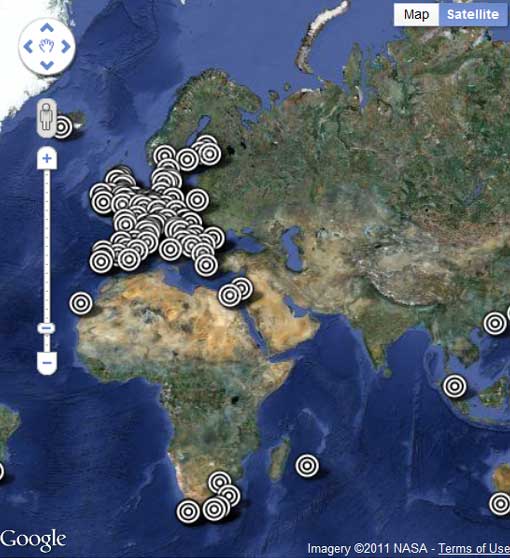
A month after its launch, more than 900 cities around the world have hosted protests
In Madrid, tens of thousands thronged the Puerta del Sol square shouting "Hands up! This is a robbery!" In Santiago, 25,000 Chileans processed through the city, pausing outside the presidential palace to hurl insults at the country's billionaire president. In Frankfurt, more than 5,000 people massed outside the European Central Bank, in scenes echoed in 50 towns and cities across Germany, from Berlin to Stuttgart. Sixty thousand people gathered in Barcelona, 100 in Manila, 3,000 in Auckland, 200 in Kuala Lumpur, 1,000 in Tel Aviv, 4,000 in London.
A month to the day after 1,000 people first turned up in Wall Street to express their outrage at corporate greed and social inequality, campaigners are reflecting on a weekend that saw a relatively modest demonstration in New York swell into a truly global howl of protest.
The Occupy campaign may have hoped, at its launch, to inspire similar action elsewhere, but few can have foreseen that within four weeks, more than 900 cities around the world would host co-ordinated protests directly or loosely affiliated to the Occupy cause.
The exact targets of protesters' anger may differ from city to city and country to country. But while their numbers remain small in many places, activists argue that Saturday's demonstrations, many of which are still ongoing - and are pledged to remain so for the foreseeable future - are evidence of a growing wave of global anger at social and economic injustice.
"This is not a battle by youth or Chilean society," said Camila Vallejo, a Chilean student leader who has become a key figure in that country's protests, and who this week travelled to Europe to forge alliances with protest movements there. "This is a world battle that transcends all frontiers."
The UN secretary general Ban Ki-moon said the global financial crisis was the trigger, adding: "What you are seeing all around the world, starting from Wall Street, people are showing their frustrations."
*Update Nov. 20, 2011*

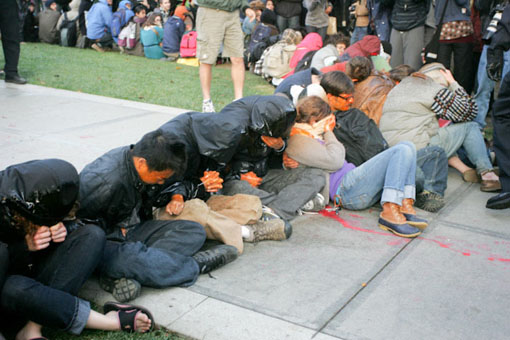

[Boing Boing] Interview with a pepper-sprayed UC Davis student
22-year-old UC Davis student W. (name withheld by request) was one of the students pepper-sprayed at point-blank range Friday by Lt. John Pike while seated on the ground, arms linked and silent.
W. tells Boing Boing that Pike sprayed them at close range with military-grade pepper spray, in a punitive manner. Pike knew the students by name from Thursday night when they "occupied" a campus plaza. The students offered Pike food and coffee and chatted with him and other officers while setting up tents. On Friday, UC Davis chancellor Linda Katehi told students they had to remove their #OWS tents for unspecified "health and safety" reasons. "Move or we're going to shoot you," Pike is reported to have yelled at one student right before delivering pepper spray. Then, turning to his fellow officers and brandishing the can in the air, "Don't worry, I'm going to spray these kids down."
XJ: So, we see in the videos and photos that you were one of the students pepper-sprayed by Lieutenant John Pike yesterday. How are you doing today?
W: I still have a burning sensation in my throat, lips and nose, especially when I start coughing, or when I'm lying in bed. Everyone who got sprayed has sustained effects like this.
XJ: Can you tell us how it happened, from where you were sitting?
W: I'd pulled my beanie hat over my eyes, to protect my eyes. I received a lot of pepper spray in my throat. I vomited twice, right away, then spent the next hour or two dry heaving. Someone said they saw him spray down my throat intentionally, but I was so freaked out, and I was blinded by my hat, so I can't verify. I did get a large quantity of pepper spray in my lungs.
Another girl near me who has asthma had an attack triggered by the pepper spray, and she was taken to the hospital.
He used military grade pepper spray on us. It's supposed to be used at a minimum of 15 feet. But he sprayed us at point blank range. Another student, 20 years old, who was sprayed and then arrested—instead of receiving medical care for the pepper spray exposure, he was made to wait in the back of a police car. His hands were sprayed, and he had intense burning in his hands throughout the evening while he was being held. He asked a police officer what they could do to stop it, and they refused to give any advice.
(unquote)
Images courtesy of Anjali Mullany / NY Daily News, Ozier Muhammad / The New York Times, Lanzilote, Anthony / Freelance NY, Tina Fineberg / AP, Jefferson Siegel for News, and Brian Nguyen / The Aggie
Photo Gallery: Occupy Wall Street Protest



















Thank you for the information! I searched all over google for this.
What a dreadful thing to happen, those people were taken out like animals and cuffed like they had no rights! I've read about the financial problems Wall Street put people into on https://www.absolutewealth.com/">https://www.absolutewealth.com/ and I agree they were entitled to their actions. The police was wrong to do what it did.